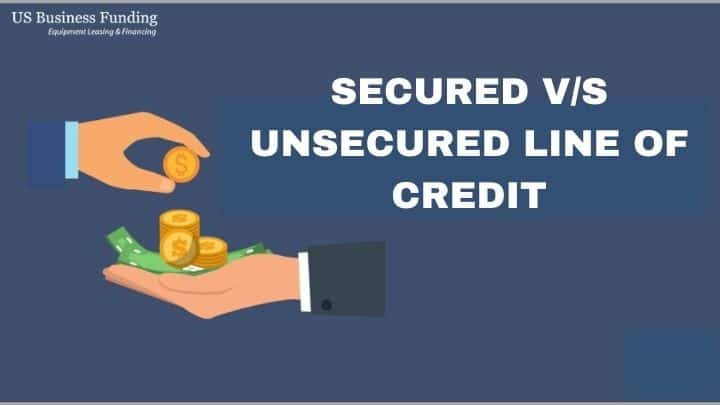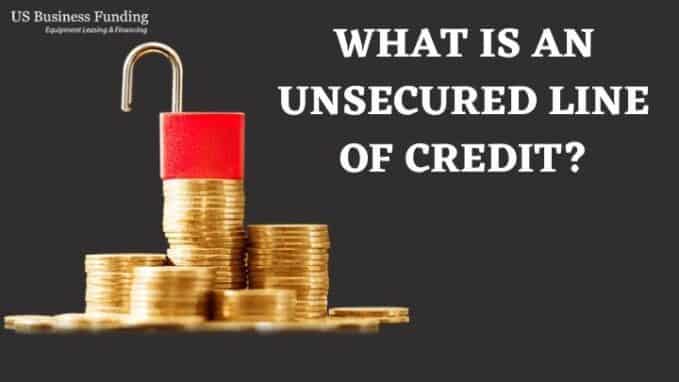Secured Vs Unsecured Line of Credit
Posted on: May 10, 2022 | Category: Business Credit·Fund Your Business

In simple terms, an individual extending or lending a sum of money to another individual is a line of credit. So, lines of credit are nothing but the amount of money borrowed from or lent to. This line of credit can be of two main types — secured and unsecured loans.
Today, we will study both these types of line of credit and see the main differences between them.
What is a Secured Line of Credit?
Whenever a line of credit is secured by some asset that can be used in the event of nonpayment of a loan, it becomes a secured loan. The lender needs some assurance or surety, which they can use in the event of nonpayment of the loan or the inability of the borrower to return the principal amount. This surety is called ‘collateral’ that helps mitigate the lender’s nonpayment risk.
For instance, when an individual wish to take a loan to purchase a house, the amount he offers as collateral becomes a secured loan. The repayment terms in this case mention forfeiture of an asset, should the principal amount and/or interest not be recovered in full.
Pros and Cons of Secured Line of Credit or Secured Loans:
Pros:
As the name suggests, a secured loan comes with security. It is, therefore, low-risk and good for the lender who knows that there is something to back the value of the loan in case individuals cannot pay it back.
Secondly, because this kind of line of credit comes with collateral, there are lower interest rates for it. This works well for borrowers who can afford more significant secured amounts due to the lower interest rate.
Overall, the safe nature of such loans makes it easier for both the borrower and the lender. With timely monthly payments, the borrower can enjoy higher credit scores which will help them in the future.
Cons:
The biggest disadvantage of secured lines of credit or a secured loan lies in the forfeiture of the asset used as collateral in the event of nonpayment of loans.
The most common examples in this category include home and automobile loans taken against the same asset as collateral — namely, house and car. Sometimes, the line of credit is forwarded against fixed assets like gold in the form of a personal loan. This is also an example of a secured loan or line of credit.
What is an Unsecured Line of Credit?

Lines of credit extend a certain sum of money through a loan to an individual. Now let us discuss the second type, namely, the unsecured lines of credit.
An unsecured line of credit means money lent to a borrower without any security or surety in exchange for such an unsecured loan. These lines of credit are usually of shorter periods of repayment, and they come with higher interest rates. This involves several reasons: firstly, you have no collateral involved, like in the case of secured credit, and such loans go for high risk to the lender. Higher interest rates mean a greater portion to repay. Then again, higher interest rates are also for the shorter duration.
An unsecured line of credit is more suitable for individuals who need finance on a more urgent basis and usually in small sums. Because there is no collateral involved, this line of credit offers benefits for those who do not have good scores. As mentioned earlier, this type comes with higher interest rates.
Pros and Cons of Unsecured Line of Credit or Unsecured Loans:
Pros:
This type is usually more flexible and great for short-term, urgent needs for finance.
As long as the individual has a good repayment capacity, these lines of credit are better for the borrower due to the shorter period of payment of interest.
Repayment terms also seem more flexible in unsecured types of loans or lines of credit.
Cons:
This credit type has a high risk for the lender, who does not ask for any collateral from the borrower in the event of nonpayment of credit extended. A credit card issuer, as an example, will only claim an amount of monthly interest in return for extending the line of credit by way of credit cards.
Though the payment period is of a shorter duration, the interest rates are quite high in this kind of credit, ultimately making it costlier for the borrower.
Examples of an unsecured line of credit include student loans, issuance of credit cards to bank customers, and mainly all kinds of personal loans where you need no collateral.
Secured vs. Unsecured Line of Credit -What are the Key Differences?
Most educational materials emphasize the availability of collateral security as the main difference between the secured and unsecured line of credit. While this is true, there are several other differences between secured and unsecured credit.
A secured line of credit is a low risk on the lender who has some surety or guarantee against the amount if it goes unpaid. This security is absent for unsecured credit channels.
Because of the above, the first line of credit comes with lower interest rates, and it is relatively easier for the borrower to pay, though the duration of credit might be longer. The opposite stands true for the second line of credit. It has a short duration but carries a higher rate of interest. The borrower must pay all installments on time to avoid piling up interest.
Then comes the suitability factor. Though we will discuss this further, a secured line of credit seems better for those with fixed, known income, greatly enhancing the ability to repay. For the latter, though, even people with a poor credit score can avail of loans, as long as they make timely payments.
Secured or Unsecured Line of Credit -Which is The Best Option for You?
This is a question that needs to undergo a careful assessment of the financial health and requirements of individuals before answering. When people or institutions judge repayment capacity, usually they consider these 5 C’s:
Character: This includes employment history, the ability of an individual to repay, and references.
Capacity: The number of resources existing with an individual that they can use for repayment.
Capital: The amount of money in capital or investment accounts that an individual possesses.
Collateral: The kind of asset/assets an individual can offer as a guarantee against nonpayment.
Condition: Lastly, the terms of the loan.
Conclusion:
We have discussed the two different types of lines of credit – secured and unsecured and the differences between them. Both are equally useful and suitable for individuals in a particular set of circumstances and with financial requirements. Ultimately, which line of credit to go for entirely depends upon the choice of the individual undertaking it after considerable thought and careful study.







